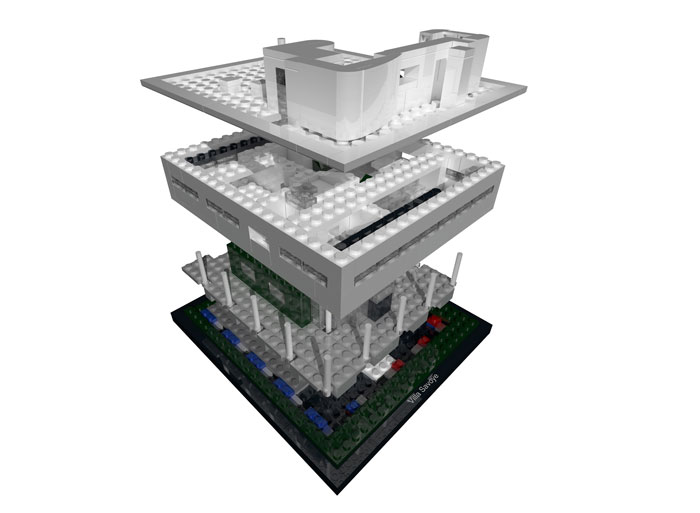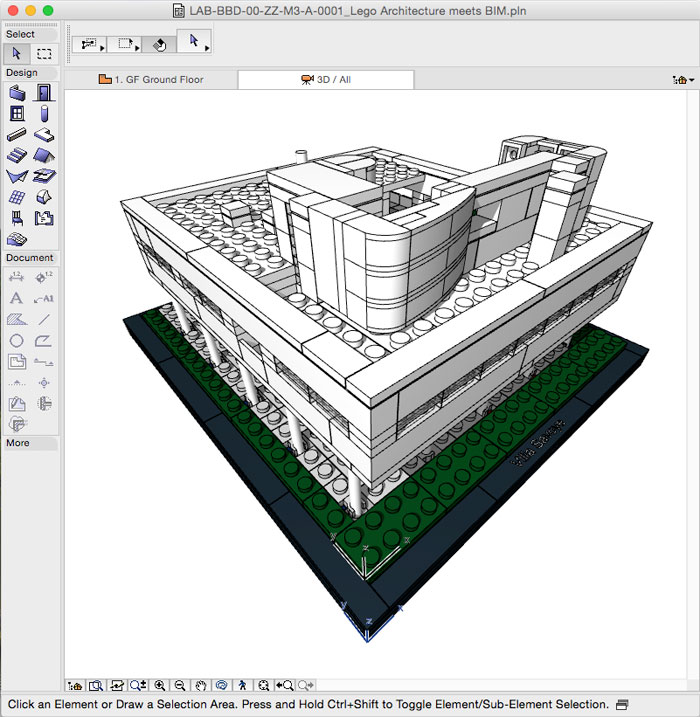While the adoption of BIM is growing, many practices still struggle to fully adapt to new processes. Bond Bryan, by contrast, has embedded BIM at its core – and has been able to expand into offering digital services to other companies as a direct result, writes Martyn Day
In the early days of BIM, its key selling point (at least according to software vendors) was that it gave users a 3D model that would automatically generate coordinated section and elevation drawings, even while editing.
Not only did this woefully undersell the benefit of the ‘I’ in BIM, it also misled many architects into thinking that BIM is a replacement for CAD — which it isn’t. The industry has been struggling with this misconception for ten years.
BIM’s true value is becoming clearer now. The UK government’s requirement for all publicly procured projects from 4 April 2016 to be completed in BIM has required a herculean effort on behalf of companies trying to adhere to rapidly developed national standards, to collaborate effectively, to deliver data at the right times, in the right formats. But from that effort has come a wealth of new insights.
In short, modelling and generating sections and elevations are not where the true value of BIM lies. To achieve BIM Level 2, the focus must instead be applied to the management, definition, and coordination of project data.
This isn’t something that comes ‘out of the box’ from any vendor. It requires knowledgeable and experienced personnel, using their skills and insights on subjects such as IFC (Industry Foundation Class), data structures, data wrangling and so on. Companies must also understand what they hope to achieve from adopting these processes.
In this respect, Bond Bryan is ahead of the game. The firm switched to using BIM way back in 1994 and, in addition to creating exciting buildings, now plays an active role in educating clients and sharing its BIM expertise with the wider industry. It has recently expanded to offer a range of digital services, through which it shares its over two decades’ worth of project-proven BIM expertise.
Introducing Bond Bryan
Today, with offices in London, Sheffield, Birmingham and Kuwait, Bond Bryan is an award-winning, research-led practice offering architectural, interior and landscape design. It offers services ranging from strategic estates advice, master planning, feasibility studies and BIM-related digital services, too.
Its staff of 120 people has significant expertise in education, research, manufacturing and workplace environments. It works on public-sector and commercial projects, to create mixed-use, commercial, residential and retail developments. It enjoys a strong reputation in the further and higher education sectors, having worked with over 50 major institutions, on projects with a combined value of well over £500 million. These include the Glasgow School of Art and the Universities of Sheffield, Nottingham, Chichester and West London.
BIM lies at the core of the company’s coordinated design process. It uses Graphisoft’s ArchiCAD as its core BIM weapon of choice. The practice’s expertise in collaboration has led to work with Bam Construct, Willmott Dixon, Wates and Balfour Beatty.

ArchiCAD BIM
In the UK, Bond Bryan is seen as a poster child for its expert use of ArchiCAD, and even had its work, The David Hockney Building for Bradford College, featured as a signature building on the box of ArchiCAD 19.
The firm has used ArchiCAD since 1994 and has become closely involved in Graphisoft’s development programme, feeding back feature requests and testing beta versions of forthcoming releases. The firm has also presented at a number of Graphisoft events, including openBIM 3D, BIM in Practice and Key Client Conference, as well as giving talks at the BIM Show Live and RTC.
It therefore follows that Bond Bryan was one of the first Graphisoft clients to deploy the company’s BIMcloud collaboration technology, enabling its design teams to share models through the cloud, while enabling easier management of projects, templates and content in a centralised location. The company currently uses version 19 but will be upgrading to version 21 once it’s released.
Digital services
Having built such a wealth of internal expertise in information handling, the firm has added digital services to its business model. The company says it prefers to think of BIM as standing for ‘Better Information Management’ and aims to assist clients in building standard processes that benefit all parties involved in the design, construction and maintenance of built assets.
Bond Bryan Digital’s information management services offer firms assistance in achieving BIM Level 2 capability, working towards BIM level 3 (due in 2020), helping to define Asset Information Requirements (AIR) and Employer’s Information Requirements (EIR), together with providing documentation management, coordination and processes. These are based around open standards, to support design and construction teams, with a focus of delivering high-quality clean data to other post-occupancy fields such as facilities management and lifecycle asset management. Bond Bryan Digital has delivered complete BIM execution plans to clients, from analysing complete supply chains to providing common data environments with model validation for COBie production [Construction Operations Building Information Exchange].
Despite the UK having tens of thousands of architects and thousands of architectural firms, the BIM hardcore is still quite a small, tight-knit community of advocates, practicing what they preach and trying to spread the BIM religion by handing on their dark arts, a bit like Jedi Knights but without the robes.
Rob Jackson, BIM expert
Even with social media sites like Twitter as places to exchange information and so many events and forums at which BIM advocates share their knowledge, some individuals still stand out for their passion and knowledge.
Rob Jackson, associate director at Bond Bryan Digital (@bondbryanBIM) is one of those experts. He’s been championing the concept of BIM, data openness and collaboration from its earliest days and has specifically examined and implemented standards for BIM data.
Through Bond Bryan Digital’s blog, Jackson has come up with a novel idea on how to explain the intricacies of BIM through the medium of Lego, having modelled Le Corbusier’s Villa Savoye and used it to explain core BIM concepts.
Talk to Rob Jackson for long enough and you will be left with no doubt that BIM software, while improving, is far from perfect. The inherent inefficiencies with which the AEC space has struggled are still ever-present. This is a challenge – and Jackson likes to solve problems.
BIM’s data problems start with the basics. Firms that don’t have standards are inconsistent and don’t check the quality of their work. In many countries, there are now emerging standards with which to comply. Here in the UK, for example, a key deliverable is COBie, a non-proprietary structured format for quantity, location, installation and maintenance of building assets. Ideally, designers would understand these requirements.
Then there is the software developer’s interpretation of this format, which can be very hit-or-miss. Some packages offer a COBie export button, for example. Users click on this and think they have complied with the standard. But this function may be fundamentally limited by how the data is structured in the core architecture of the BIM software, which may not have the granularity for proper definition, or may simply not have a correlating data field.
Added to all this, software developers insist on upgrading and changing their applications every year, or even more frequently, which can change the way they structure data. National standards continue to evolve, sometimes at a bewildering pace.
The one thing users can be sure of is that simply clicking on an COBie export button will not pass a data integrity test. Things get even more messy when they need to generate a COBie drop from federated databases, which originate from software created by different developers from different firms and with different standards, some of which may not quality-check their output. As Jackson explains, “I see my role as helping designers deliver the right information, and by developing a process, you consistently deliver models created to standards. It’s easier to tackle at source, than [to] fix when we get to the stage of merging IFCs. It’s all about getting information to the client that is good and to do that consistently. However in BIM, everything is constantly changing, it’s a never-ending cycle, it’s constantly moving — but we need to establish levels of confidence.”
Acquiring this knowledge may mean breaking things: Jackson regularly carries out geometry and data tests on many industry tools, to identify what elements go in but don’t come out, to understand the limitations and to seek out remedies.
With so much BIM data flying around between authoring and visualisation tools, common data environments, COBie, IFC readers and so on, it can be surprising what data gets filtered out in the process. BIM data exchange is rarely a lossless process. Jackson and his team are so skilled at this that they’re hired by software vendors to test their code.
“The industry is struggling to deliver consistent reliable information and it’s no surprise,” says Jackson. “For instance, Autodesk Revit has an ‘IFC out’ and a ‘COBie out’, when COBie is a subset of IFC — but they are developed by different teams. “Then there are user inconsistencies. We have worked on projects where all participants are using the same authoring tool, but there are huge discrepancies. We end up spending a lot of time mapping stuff. We have to clean it up into a format that is usable.”
Here, Bond Bryan Digital’s weapon of choice is Solibri, Jackson explains. “As far as we are concerned, working in an Open BIM environment is about conforming to IFC, COBie and BCF formats. We perform element classification tests, merge federated data, perform clash detection and build rules to validate models using Solibri. We make sure we achieve high-quality information take-off and create filters on classifications to check the quality of data.”
While Solibri acts as a common data environment for wrangling IFC data for validation, Bond Bryan Digital is currently investigating the quickly developing world of generic BIM common data environments, with clients using disparate systems from Dropbox and Buzzsaw to dRofus, which Nemetschek acquired at the end of last year. Jackson has yet to find a truly outstanding one, but is increasing his exposure to the options available by working with clients’ different choices.
With so many firms struggling to move BIM data around their offices, I asked Jackson about Bond Bryan’s own set-up. “We have ArchiCAD BIMcloud across all offices. We have never required data compressors. As to file sizes, I don’t really know anymore; with BIMcloud, I don’t see them and BIMcloud just sends the data that changes, not the whole model.
“I guess as some indication, our IFCs get to be 150MB. We use standard off-the-shelf Macs. Nobody complains about speed. When creating renderings is perhaps the only time users wait but, day to day, the computer operates faster than the users. Speed is not an issue on our project work. If you asked our users for their top 20 issues, speed would be at the bottom. The number one issue would be the complexity of my templates – I won’t deny it!”
Bond Bryan has a single Revit Suite and while the firm has considered setting up a small Revit team in the past, it decided that supporting two BIM tools was crazy.
“I think ArchiCAD is the best design tool as it’s less structured,” says Jackson. “Revit is very structured, so great as an engineering tool, but as an architectural tool, I would personally rather create workflows in ArchiCAD as you can have flexibility, while still being able to produce structured data.”
One of my regular questions to BIM experts is how much 2D work they do to their auto-generated sections. The more 2D detail is added, the less benefit they get from automatic coordinated updates when the model changes.
According to Jackson, “We embellish the model with 2D over the top, I guess to make it what people would expect the output to be. Everything we try not to do! It’s [about] level of information, which goes back to not trusting contractors, adding detailed specifications to the drawing to ensure everything is unambiguous. There’s always a fear that if you don’t add that detail, mistakes will happen. But I’d love the industry to move away from being drawing-based.”
When it comes to hiring staff, does Bond Bryan automatically look for experienced ArchiCAD users? “Obviously, at the moment, the industry is massively constrained with a skills shortage. We don’t advertise for ArchiCAD users specifically, we just look for good architects or technicians. As far as we are concerned, those are the core criteria and our chosen authoring tool, ArchiCAD, can be learnt in a week. It’s all about attitude and mindset.
“We get a lot of interest from young students, because we go out and give lectures and talks. They see what we’re doing and the level of expertise we have with the tools and [they] approach us,” he says.

Evolving BIM
In many ways, the BIM market is still evolving, trying to sort itself out. The problems include proprietary file formats, inconsistent data formatting, poor compliance to data formats, low levels of openness and users who probably don’t achieve good quality or standards in 2D, then going on to replicate bad practices and bad habits in BIM.
While there has been a rush to adopt BIM, there hasn’t necessarily been a rush to adapt to it, or spend much time ensuring that the data that gets delivered is correct. Again, just because your software has a COBie export button, that doesn’t mean it conforms to the standard.
Architectural practices need a new breed of people — IT-savvy people who have the time and interest to experiment in order to address shortfalls in software and the skill levels they encounter in their dealings with collaborators and clients. Many firms are setting up internal R&D teams to ease the deployment of new technology and to wrangle data. From talking with Rob Jackson, it seems clear that firms need to identify their natural puzzle- solvers to drive standards internally and interface with federated teams.
It’s also clear that getting ahead in BIM knowledge opens new business opportunities. Bond Bryan can now bid on a number of levels: design, strategy, coordination, quality assessment and many others. By working with clients in a wider range of capacities, other opportunities arise and the company acquires even more knowledge. In other words, it’s a virtuous cycle.
Looking at BIM from a data-centric viewpoint requires asking different questions of internal processes and introducing a culture of self-checking. Creating a model and coordinated drawings really is the most elementary part of BIM. The bigger picture is getting a handle on all the data that BIM models possess and fathoming out how to get that data in the right format, in order to meaningfully share it with someone — as a schedule, as an IFC, as a COBie sheet, or whatever else is required.
It’s not enough to be using the same BIM modelling tool: inconsistent standards, training and quality can wreak havoc on a collaborative project in the design and construction phases and can go on to negatively impact the occupancy phase. Add to the mix constantly evolving software, often released on yearly upgrade cycles, and the shifting sands of national and international BIM standards, and you’ve got an even bigger challenge with which to contend.
But tackling that challenge — and doing it smartly — is exactly how Bond Bryan Digital has found its niche.
The Bond Bryan Digital Blog
Bond Bryan Digital’s blog is a mixture of practice news and technology updates – but it’s also where Rob Jackson has created a series of very informative and easy-to-comprehend explanations of BIM through the medium of LEGO and Le Corbusier’s Villa Savoye (featured on the front cover of this edition of AEC Magazine).
The series, now 22 posts in length, offers advice to clients and architects, as well as BIM laypeople, covering all the key concepts of BIM.
These make it clear that, while many people continue to think of a model and its geometry as an end in itself, these really are only the start of many important processes that deliver value throughout a building’s lifecycle.
With each entry, Jackson explains the concepts, processes and benefits of modelling, model views, visualisation, object libraries, Levels of Detail (LODs), augmented reality, schedules, and so on.
The series is a great starting point for any beginner to the concept of BIM. Our understanding is that Jackson intends to continue with the series and has even bigger plans for additional LEGO-based informative materials.



If you enjoyed this article, subscribe to AEC Magazine for FREE






